I'm making a application to track a veicle based in GPS coordinates.
I created a SurfaceView to draw the field, vehicle and the path (route) for him.
The result looked like this:

The black dots represent the coming of GPS coordinates, and blue rectangles would be the area covered by the path traveled. (the width of the path is configurable)
The way I'm drawing with blue rectangles (this is my question) which are the area covered by the path traveled. (the width of the path is configurable)
With that I need to overcome some situation.
- I need to calculate the field's rotation angle so that the path always get left behind. (completed)
- I need to calculate the angle of rotation of each rectangle so they are facing towards the vehicle. (completed)
In the future I will need:
- Detect when the vehicle passes twice in the same place. (based on the path traveled)
- Calculate the area (m²) all traveled by the vehicle.
I would like some tips for draw this path.
My code:
public void draw(Canvas canvas) {
Log.d(getClass().getSimpleName(), "draw");
canvas.save();
// translate canvas to vehicle positon
canvas.translate((float) center.cartesian(0), (float) center.cartesian(1));
float fieldRotation = 0;
if (trackerHistory.size() > 1) {
/*
Before drawing the way, only takes the last position and finds the angle of rotation of the field.
*/
Vector lastPosition = new Vector(convertToTerrainCoordinates(lastPoint));
Vector preLastPosition = new Vector(convertToTerrainCoordinates(preLastPoint));
float shift = (float) lastPosition.distanceTo(preLastPosition);
/*
Having the last coordinate as a triangle, 'preLastCoord' saves the values of the legs, while 'shift' is the hypotenuse
*/
// If the Y offset is negative, then the opposite side is the Y displacement
if (preLastPosition.cartesian(1) < 0) {
// dividing the opposite side by hipetenusa, we have the sine of the angle that must be rotated.
double sin = preLastPosition.cartesian(1) / shift;
// when Y is negative, it is necessary to add or subtract 90 degrees depending on the value of X
// The "Math.asin()" calculates the radian arc to the sine previously calculated.
// And the "Math.toDegress()" converts degrees to radians from 0 to 360.
if (preLastPosition.cartesian(0) < 0) {
fieldRotation = (float) (Math.toDegrees(Math.asin(sin)) - 90d);
} else {
fieldRotation = (float) (Math.abs(Math.toDegrees(Math.asin(sin))) + 90d);
}
}
// if not, the opposite side is the X offset
else {
// dividing the opposite side by hipetenusa have the sine of the angle that must be rotated.
double senAngulo = preLastPosition.cartesian(0) / shift;
// The "Math.asin()" calculates the radian arc to the sine previously calculated.
// And the "Math.toDegress()" converts degrees to radians from 0 to 360.
fieldRotation = (float) Math.toDegrees(Math.asin(senAngulo));
}
}
final float dpiTrackerWidth = Navigator.meterToDpi(trackerWidth); // width of rect
final Path positionHistory = new Path(); // to draw the route
final Path circle = new Path(); // to draw the positions
/*
Iterate the historical positions and draw the path
*/
for (int i = 1; i < trackerHistory.size(); i++) {
Vector currentPosition = new Vector(convertToTerrainCoordinates(trackerHistory.get(i))); // vector with X and Y position
Vector lastPosition = new Vector(convertToTerrainCoordinates(trackerHistory.get(i - 1))); // vector with X and Y position
circle.addCircle((float) currentPosition.cartesian(0), (float) currentPosition.cartesian(1), 3, Path.Direction.CW);
circle.addCircle((float) lastPosition.cartesian(0), (float) lastPosition.cartesian(1), 3, Path.Direction.CW);
if (isInsideOfScreen(currentPosition.cartesian(0), currentPosition.cartesian(1)) ||
isInsideOfScreen(lastPosition.cartesian(0), lastPosition.cartesian(1))) {
/*
Calcule degree by triangle sides
*/
float shift = (float) currentPosition.distanceTo(lastPosition);
Vector dif = lastPosition.minus(currentPosition);
float sin = (float) (dif.cartesian(0) / shift);
float degress = (float) Math.toDegrees(Math.asin(sin));
/*
Create a Rect to draw displacement between two coordinates
*/
RectF rect = new RectF();
rect.left = (float) (currentPosition.cartesian(0) - (dpiTrackerWidth / 2));
rect.right = rect.left + dpiTrackerWidth;
rect.top = (float) currentPosition.cartesian(1);
rect.bottom = rect.top - shift;
Path p = new Path();
Matrix m = new Matrix();
p.addRect(rect, Path.Direction.CCW);
m.postRotate(-degress, (float) currentPosition.cartesian(0), (float) currentPosition.cartesian(1));
p.transform(m);
positionHistory.addPath(p);
}
}
// rotates the map to make the route down.
canvas.rotate(fieldRotation);
canvas.drawPath(positionHistory, paint);
canvas.drawPath(circle, paint2);
canvas.restore();
}
My goal is to have something like this application: https://play.google.com/store/apps/details?id=hu.zbertok.machineryguide (but only in 2D for now)
EDIT:
To clarify a bit more my doubts:
- I do not have much experience about it. I would like a better way to draw the path. With rectangles it was not very good. Note that the curves are some empty spaces.
- Another point is the rotation of rectangles, I'm rotating them at the time of drawing. I believe this will make it difficult to detect overlaps
- I believe I need math help for the rotation of objects and overlapping detection. And it also helps to draw the path of a filled shape.



